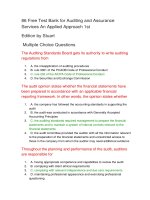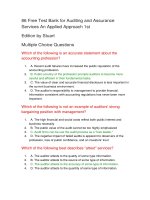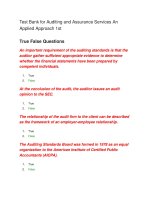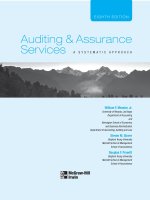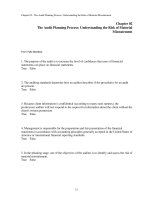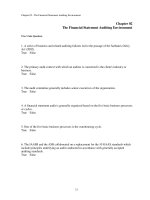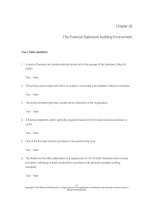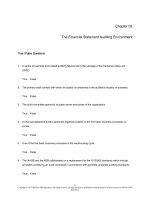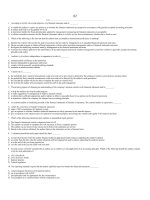Auditing and assurance services an applied approach 1st edition stuart test bank
Bạn đang xem bản rút gọn của tài liệu. Xem và tải ngay bản đầy đủ của tài liệu tại đây (370.05 KB, 99 trang )
Chapter 02 - The Audit Planning Process: Understanding the Risk of Material Misstatement
Chapter 02
The Audit Planning Process: Understanding the Risk of Material
Misstatement
True / False Questions
1. The purpose of the audit is to increase the level of confidence that users of financial
statements can place on financial statements.
True False
2. The auditing standards determine how an auditor describes if the procedures for an audit
are present.
True False
3. Because client information is confidential (according to many state statutes), the
predecessor auditor will not respond to the request for information about the client without the
client's written permission.
True False
4. Management is responsible for the preparation and fair presentation of the financial
statements in accordance with accounting principles generally accepted in the United States of
America or international financial reporting standards.
True False
5. In the planning stage, one of the objectives of the auditor is to identify and assess the risk of
material misstatement.
True False
2-1
Chapter 02 - The Audit Planning Process: Understanding the Risk of Material Misstatement
6. Relevant assertions are assertions made by the auditor about the financial statements of the
company that have a reasonable possibility of containing a misstatement that would cause the
statements to be misstated.
True False
7. A material misstatement is an error or fraud in the financial statements that might cause a
user of the financial statements to change his opinion about the company.
True False
8. During the planning process, the auditor determines the overall audit strategy for the audit.
This strategy establishes the scope, timing, and direction of the audit and guides the auditor
when he prepares the audit plan.
True False
9. The auditor should document the audit strategy in the audit report containing the key
decisions about the scope, timing, and conduct of the audit.
True False
10. The audit plan will be used to gather sufficient appropriate evidence to reduce audit risk to
a near zero level.
True False
11. Audit risk determines the amount of evidence gathered. The amount of evidence gathered
determines the audit fees.
True False
12. When an accounting firm establishes a system of quality control, the firm's objective is to
obtain assurance that the firm complied with applicable legal and regulatory requirements.
True False
2-2
Chapter 02 - The Audit Planning Process: Understanding the Risk of Material Misstatement
Multiple Choice Questions
13. Which of the following statements is correct about the objective of the audit process?
A. Generally accepted auditing standards require the auditor to obtain assurance about
whether the financial statements are free from all misstatements.
B. Reasonable assurance is obtained by the auditor when he has obtained sufficient
appropriate audit evidence to reduce audit risk to an acceptably low level.
C. A misstatement is an error or fraud in the financial statements that might cause a user of
the financial statements to change his decision about the company.
D. Sufficient appropriate audit evidence refers to the persuasiveness of the evidence gathered.
14. Which of the following statements is correct about the objective of the audit process?
A. Generally accepted auditing standards require the auditor to obtain reasonable assurance
about whether the financial statements are free from material misstatements.
B. Assurance is obtained by the auditor when he has obtained sufficient appropriate audit
evidence to reduce audit risk to an acceptably low level.
C. A misstatement is an error or fraud in the financial statements that might cause a user of
the financial statements to change his decision about the company.
D. Sufficient appropriate audit evidence refers to the persuasiveness of the evidence gathered.
15. Which of the following statements is correct about the objective of the audit process?
A. Generally accepted auditing standards require the auditor to obtain assurance about
whether the financial statements are free from all misstatements.
B. Assurance is obtained by the auditor when he has obtained sufficient appropriate audit
evidence to reduce audit risk to an acceptably low level.
C. A material misstatement is an error or fraud in the financial statements that might cause a
user of the financial statements to change his decision about the company.
D. Sufficient appropriate audit evidence refers to the persuasiveness of the evidence gathered.
2-3
Chapter 02 - The Audit Planning Process: Understanding the Risk of Material Misstatement
16. Which of the following statements is correct about the objective of the audit process?
A. Generally accepted auditing standards require the auditor to obtain assurance about
whether the financial statements are free from all misstatements.
B. Assurance is obtained by the auditor when he has obtained sufficient appropriate audit
evidence to reduce audit risk to an acceptably low level.
C. A misstatement is an error or fraud in the financial statements that might cause a user of
the financial statements to change his decision about the company.
D. Sufficient appropriate audit evidence refers to the quantity and quality of the evidence
gathered.
17. Audit risk is defined as
A. the risk that the auditor issues an opinion saying that the financial statements are not
materially misstated when they are.
B. the risk that the auditor fails to issue an opinion saying that the financial statements are
materially misstated when they are.
C. the risk that the auditor does not detect a material misstatement in the financial statements.
D. the risk that the auditor does detect a material misstatement in the financial statements but
fails to report the material misstatement.
E. the risk that the auditor issues an opinion saying that the financial statements are materially
misstated when they are not.
18. Which of the following are the three main parts of the audit process?
A. (1) The planning process, (2) The testing process, and (3) The reporting process.
B. (1) The planning process, (2) The testing process, and (3) The decision process.
C. (1) The planning process, (2) The evaluation process, and (3) The decision process.
D. (1) The risk assessment process, (2) The testing process, and (3) The decision process.
2-4
Chapter 02 - The Audit Planning Process: Understanding the Risk of Material Misstatement
19. The auditing standards describe how an auditor determines if the preconditions for an
audit are present. Which of the following would be a precondition for an audit?
A. The auditor obtains the agreement of management that it acknowledges and understands its
responsibility for the issuing of the financial statements in accordance with the financial
reporting framework.
B. The auditor obtains the agreement from management that it acknowledges and understands
its responsibility for internal controls so financial statements can be prepared free of material
misstatement.
C. The auditor obtains the agreement of management that it agrees to provide the auditor with
all information that management is aware of that might be relevant to the preparation of the
financial statements.
D. The auditor determines whether the financial reporting framework (the set of accounting
standards) used by the client to prepare the financial statements is acceptable.
20. The auditing standards describe how an auditor determines if the preconditions for an
audit are present. Which of the following would be a precondition for an audit?
A. The auditor obtains the agreement of management that it acknowledges and understands its
responsibility for the preparation of the financial statements in accordance with the financial
reporting framework.
B. The auditor obtains the agreement from management that it acknowledges and understands
its responsibility for internal controls so financial statements can be prepared free of material
misstatement.
C. The auditor obtains the agreement of management that it agrees to provide the auditor with
all information that management is aware of that might be relevant to the preparation of the
financial statements.
D. The auditor determines whether the financial reporting framework (the set of internal
control standards) used by the client to prepare the financial statements is acceptable.
2-5
Chapter 02 - The Audit Planning Process: Understanding the Risk of Material Misstatement
21. The auditing standards describe how an auditor determines if the preconditions for an
audit are present. Which of the following would be a precondition for an audit?
A. The auditor obtains the agreement of management that it acknowledges and understands its
responsibility for the issuing of the financial statements in accordance with the financial
reporting framework.
B. The auditor obtains the agreement from management that it acknowledges and understands
its responsibility for internal controls so financial statements can be prepared free of
misstatement.
C. The auditor obtains the agreement of management that it agrees to provide the auditor with
all information that management is aware of that might be relevant to the preparation of the
financial statements.
D. The auditor determines whether the financial reporting framework (the set of internal
control standards) used by the client to prepare the financial statements is acceptable.
22. The auditing standards describe how an auditor determines if the preconditions for an
audit are present. Which of the following would be a precondition for an audit?
A. The auditor obtains the agreement of management that it acknowledges and understands its
responsibility for the issuing of the financial statements in accordance with the financial
reporting framework.
B. The auditor obtains the agreement from management that it acknowledges and understands
its responsibility for internal controls so financial statements can be prepared free of material
misstatement.
C. The auditor obtains the agreement of management that it will provide the auditor with all
information that management is aware of that might be relevant to the preparation of the
financial statements and any other information the auditor may request.
D. The auditor determines whether the financial reporting framework (the set of internal
control standards) used by the client to prepare the financial statements is acceptable.
23. Generally accepted auditing standards require the auditor to obtain sufficient appropriate
audit evidence to reduce audit risk to an acceptable level. If the auditor determines that he
cannot comply with this standard due to the risk level present in the client before the
engagement, he will
A. reject the engagement.
B. advise the client on how to reduce the risk level.
C. increase substantive testing to reduce the risk to an acceptable level.
D. increase control testing to reduce the risk to an acceptable level.
2-6
Chapter 02 - The Audit Planning Process: Understanding the Risk of Material Misstatement
24. When an auditor agrees to perform an audit because the preconditions for an audit have
been met and the auditor believes that he can gather sufficient appropriate audit evidence to
reduce audit risk to an acceptably low level, an engagement letter is prepared. The
engagement letter includes:
A. the purpose of the audit (to express an opinion on particular financial statements).
B. management's assistance (to prepare the financial statements, select accounting policies,
establish effective internal controls, design programs to prevent and detect fraud, provide
written representation, inform the auditor of subsequent events that may affect the financial
statements, and make all financial records and information available to the auditor).
C. the auditor's responsibilities (to conduct the audit in accordance with generally accepted
auditing standards and obtain an understanding of the client's internal control).
D. the internal control limitations of an audit engagement (material misstatements may not be
detected).
25. When an auditor agrees to perform an audit because the preconditions for an audit have
been met and the auditor believes that he can gather sufficient appropriate audit evidence to
reduce audit risk to an acceptably low level, an engagement letter is prepared. The
engagement letter includes:
A. the objective and scope of the audit (to express an opinion on particular financial
statements).
B. management's assistance (to prepare the financial statements, select accounting policies,
establish effective internal controls, design programs to prevent and detect fraud, provide
written representation, inform the auditor of subsequent events that may affect the financial
statements, and make all financial records and information available to the auditor).
C. the auditor's performance (to conduct the audit in accordance with generally accepted
auditing standards and obtain an understanding of the client's internal control).
D. the internal control limitations of an audit engagement (material misstatements may not be
detected).
2-7
Chapter 02 - The Audit Planning Process: Understanding the Risk of Material Misstatement
26. When an auditor agrees to perform an audit because the preconditions for an audit have
been met and the auditor believes that he can gather sufficient appropriate audit evidence to
reduce audit risk to an acceptably low level, an engagement letter is prepared. The
engagement letter includes:
A. the purpose of the audit (to express an opinion on particular financial statements).
B. management's responsibilities (to prepare the financial statements, select accounting
policies, establish effective internal controls, design programs to prevent and detect fraud,
provide written representation, inform the auditor of subsequent events that may affect the
financial statements, and make all financial records and information available to the auditor).
C. the auditor's performance (to conduct the audit in accordance with generally accepted
auditing standards and obtain an understanding of the client's internal control).
D. the internal control limitations of an audit engagement (material misstatements may not be
detected).
27. When an auditor agrees to perform an audit because the preconditions for an audit have
been met and the auditor believes that he can gather sufficient appropriate audit evidence to
reduce audit risk to an acceptably low level, an engagement letter is prepared. The
engagement letter includes:
A. the purpose of the audit (to express an opinion on particular financial statements).
B. management's assistance (to prepare the financial statements, select accounting policies,
establish effective internal controls, design programs to prevent and detect fraud, provide
written representation, inform the auditor of subsequent events that may affect the financial
statements, and make all financial records and information available to the auditor).
C. the auditor's performance (to conduct the audit in accordance with generally accepted
auditing standards and obtain an understanding of the client's internal control).
D. the inherent limitations of an audit engagement (material misstatements may not be
detected).
28. When an auditor agrees to perform an audit because the preconditions for an audit have
been met and the auditor believes that he can gather sufficient appropriate audit evidence to
reduce audit risk to an acceptably low level, an engagement letter is prepared. The
engagement letter includes:
A. arrangements regarding the planning and performance of the audit, including the
composition of the audit team.
B. the basis on which fees are computed are based on an unqualified audit opinion.
C. arrangements concerning the opinions of other auditors and specialists in the audit.
D. arrangements concerning the opinions of internal auditors and other staff of the company.
E. arrangements to be made with the predecessor auditor in the case of a follow up audit.
2-8
Chapter 02 - The Audit Planning Process: Understanding the Risk of Material Misstatement
29. When an auditor agrees to perform an audit because the preconditions for an audit have
been met and the auditor believes that he can gather sufficient appropriate audit evidence to
reduce audit risk to an acceptably low level, an engagement letter is prepared. The
engagement letter includes:
A. the basis on which fees are computed are based on an unqualified audit opinion.
B. arrangements regarding the methods of testing of the audit, including the composition of
the audit team.
C. arrangements concerning the involvement of other auditors and specialists in the audit.
D. arrangements concerning the opinions of internal auditors and other staff of the company.
E. arrangements to be made with the predecessor auditor in the case of a follow up audit.
30. When an auditor agrees to perform an audit because the preconditions for an audit have
been met and the auditor believes that he can gather sufficient appropriate audit evidence to
reduce audit risk to an acceptably low level, an engagement letter is prepared. The
engagement letter includes:
A. the basis on which fees are computed are based on an unqualified audit opinion.
B. arrangements regarding the methods and testing of the audit, including the composition of
the audit team.
C. arrangements concerning the opinions of other auditors and specialists in the audit.
D. arrangements concerning the involvement of internal auditors and other staff of the
company.
E. arrangements to be made with the predecessor auditor in the case of a follow up audit.
31. When an auditor agrees to perform an audit because the preconditions for an audit have
been met and the auditor believes that he can gather sufficient appropriate audit evidence to
reduce audit risk to an acceptably low level, an engagement letter is prepared. The
engagement letter includes:
A. the basis on which fees are computed are based on an unqualified audit opinion.
B. arrangements regarding the methods of testing of the audit, including the composition of
the audit team.
C. arrangements concerning the opinions of other auditors and specialists in the audit.
D. arrangements concerning the opinions of internal auditors and other staff of the company.
E. arrangements to be made with the predecessor auditor in the case of an initial audit.
2-9
Chapter 02 - The Audit Planning Process: Understanding the Risk of Material Misstatement
32. In the request for information from the predecessor auditor, the new auditor may ask for
information about the following item
A. the integrity of management.
B. disagreements with management about the fee payment schedule.
C. communications to management regarding fraud and noncompliance with laws or
regulations by the company.
D. communications to management and those charged with governance regarding significant
deficiencies and material weaknesses in financial reporting.
33. In the request for information from the predecessor auditor, the new auditor may ask for
information about the following item
A. the integrity of those charged with governance.
B. disagreements with management about accounting policies or auditing procedures.
C. communications to management regarding fraud and noncompliance with laws or
regulations by the company.
D. communications to management and those charged with governance regarding significant
deficiencies and material weaknesses in financial reporting.
34. In the request for information from the predecessor auditor, the new auditor may ask for
information about the following item
A. the integrity of those charged with governance.
B. disagreements with management about the fee payment schedule.
C. communications to those charged with governance regarding fraud and noncompliance
with laws or regulations by the company.
D. communications to management and those charged with governance regarding significant
deficiencies and material weaknesses in financial reporting.
35. In the request for information from the predecessor auditor, the new auditor may ask for
information about the following item
A. the integrity of those charged with governance.
B. disagreements with management about the fee payment schedule.
C. communications to management regarding fraud and noncompliance with laws or
regulations by the company.
D. the predecessor auditor's understanding regarding the reasons for the change of auditors.
2-10
Chapter 02 - The Audit Planning Process: Understanding the Risk of Material Misstatement
36. When an auditor signs an engagement letter
A. the auditor may commence the audit
B. the client has an obligation to pay the audit fee
C. the auditor has a contract to perform the audit
D. the client is attesting to the accuracy of the financial statements
37. Step 2 of the planning process is the risk assessment phase. At this stage of the planning
process the objective of the auditor is to identify and assess the risk of material misstatement.
The auditor does this by
A. gaining an understanding of the company and its environment, including the company's
internal controls
B. gaining an understanding of the company's industry, including the company's competition
C. developing an audit strategy to respond to the risk of material misstatement
D. determining risk assessment procedures to assess the risk of material misstatement at the
financial statement and assertion level
38. Step 2 of the planning process is the risk assessment phase. At this stage of the planning
process the objective of the auditor is to identify and assess the risk of material misstatement.
The auditor does this by
A. gaining an understanding of the company and its management, including the company's
financial controls
B. gaining an understanding of the company's industry, including the company's competition
C. determining materiality
D. determining risk assessment procedures to assess the risk of material misstatement at the
financial statement and assertion level
39. Step 2 of the planning process is the risk assessment phase. At this stage of the planning
process the objective of the auditor is to identify and assess the risk of material misstatement.
The auditor does this by
A. gaining an understanding of the company and its management, including the company's
financial controls
B. gaining an understanding of the company's industry, including the company's competition
C. developing an audit strategy to respond to the risk of material misstatement
D. performing risk assessment procedures to assess the risk of material misstatement at the
financial statement and assertion level
2-11
Chapter 02 - The Audit Planning Process: Understanding the Risk of Material Misstatement
40. How does the auditor gain an understanding of the entity and its environment? The
auditing standards require the auditor to understand
A. industry, regulatory and other external factors relevant to the entity
B. the nature of management of the entity, including its operations, ownership and governance
structures, the types of investments management makes, and the way the entity is structured
and financed
C. management's selection and use of accounting policies, including any changes in these
policies
D. management's objectives and strategies and the related business risks that may lead to the
risk of material misstatement
41. How does the auditor gain an understanding of the entity and its environment? The
auditing standards require the auditor to understand
A. industry, regulatory and other external factors that management deems relevant to the
entity
B. the nature of the entity, including its operations, ownership and governance structures, the
types of investments the entity makes, and the way the entity is structured and financed
C. management's selection and use of accounting policies, including any changes in these
policies
D. management's objectives and strategies and the related business risks that may lead to the
risk of material misstatement
42. How does the auditor gain an understanding of the entity and its environment? The
auditing standards require the auditor to understand
A. industry, regulatory and other external factors that management deems relevant to the
entity
B. the nature of management of the entity, including its operations, ownership and governance
structures, the types of investments management makes, and the way the entity is structured
and financed
C. the entity's selection and use of accounting policies, including any changes in these policies
D. management's objectives and strategies and the related business risks that may lead to the
risk of material misstatement
2-12
Chapter 02 - The Audit Planning Process: Understanding the Risk of Material Misstatement
43. How does the auditor gain an understanding of the entity and its environment? The
auditing standards require the auditor to understand
A. industry, regulatory and other external factors that management deems relevant to the
entity
B. the nature of management of the entity, including its operations, ownership and governance
structures, the types of investments management makes, and the way the entity is structured
and financed
C. management's selection and use of accounting policies, including any changes in these
policies
D. the entity's objectives and strategies and the related business risks that may lead to the risk
of material misstatement
44. Internal controls are
A. usually necessary to run the company
B. part of the environment of the client
C. implemented in areas where fraud risk is greatest
D. are only necessary if audit testing is going to rely on them
45. For internal controls that are relevant to the audit, the auditor should
A. understand incentives of the company to misstate the financial statements
B. identify the relevant financial statement accounts with the greatest potential for
misstatements
C. understand the design of the controls and the implementation of the controls
D. design audit procedures to determine that the accounts are fairly presented according to the
applicable financial reporting framework
46. After the auditor determines materiality for the company, the auditor can determine
A. the accounts where maximum audit testing is required
B. the level of misstatement necessary for the misstatement to be considered material
C. the value of clear and accurate financial disclosures
D. the auditor's responsibility to outside users of financial statements to provide financial
information consistent with accounting regulations
2-13
Chapter 02 - The Audit Planning Process: Understanding the Risk of Material Misstatement
47. The determination of materiality is based on
A. generally accepted auditing standards
B. the likelihood of material misstatements being present
C. the professional judgment of the auditor
D. the understanding of the entity's internal controls
48. The auditing standards specify that misstatements are considered to be material if
A. they individually or in the aggregate could reasonably be expected to influence the
decisions of management
B. they could reasonably be expected to influence the decisions of knowledgeable users of the
financial statements
C. the client determines that they could be expected to influence the decisions of outside users
of the financial statements
D. they individually or in the aggregate could reasonably be expected to influence the
decisions of users of the financial statements
49. Once the auditor calculates materiality, he uses the concept of materiality in
A. determining the timing of substantive tests
B. planning and performing the audit
C. evaluating the effect of corrected misstatements on the financial statements
D. determining if there are any deficiencies in internal control
E. B and C
50. Once the auditor calculates materiality, he uses the concept of materiality
A. to determine the timing of substantive tests
B. to determine the amount below which misstatements will always be evaluated as
immaterial
C. to evaluate the effect of uncorrected misstatements on the financial statements
D. to determine if there are any deficiencies in internal control
2-14
Chapter 02 - The Audit Planning Process: Understanding the Risk of Material Misstatement
51. In planning the audit, the auditor makes decisions about the size of misstatements that will
be considered material. These decisions allow the auditor to
A. determine the nature, timing, and extent of inherent risk assessment procedures
B. identify and assess the risk of misstatement
C. determine the nature, timing, and extent of audit procedures
D. establish an amount below which misstatements will always be evaluated as immaterial
E. C and D
52. In planning the audit, the auditor makes decisions about the size of misstatements that will
be considered material. These decisions allow the auditor to
A. determine the nature, timing, and extent of risk assessment procedures
B. identify and assess the risk of misstatement
C. determine the nature, timing, and extent of internal control procedures
D. establish an amount below which misstatements will always be evaluated as immaterial
E. A and D
53. In planning the audit, the auditor makes decisions about the size of misstatements that will
be considered material. These decisions allow the auditor to
A. determine the nature, timing, and extent of inherent risk assessment procedures
B. identify and assess the risk of material misstatement
C. determine the nature, timing, and extent of internal control procedures
D. establish an amount below which misstatements will always be evaluated as immaterial
54. In planning the audit, the auditor makes decisions about the size of misstatements that will
be considered material. These decisions do not allow the auditor to
A. determine the nature, timing, and extent of audit procedures
B. identify and assess the risk of material misstatement
C. determine the nature, timing, and extent of risk assessment procedures
D. establish an amount below which misstatements will always be evaluated as immaterial
2-15
Chapter 02 - The Audit Planning Process: Understanding the Risk of Material Misstatement
55. In the planning process, the auditor assesses the risk that misstatements have occurred in
the financial statements. The source of misstatements includes
A. inaccuracies in gathering or processing data used to audit the financial statements
B. the use of auditing standards that may be unreasonable or inappropriate
C. differences between the amount or classification of a financial statement item and what
should have been reported under generally accepted auditing standards
D. omissions of financial statement explanations
E. financial statement disclosures that are not in accordance with generally accepted
accounting principles
56. In the planning process, the auditor assesses the risk that misstatements have occurred in
the financial statements. The source of misstatements includes
A. the use of auditing standards that the auditor may consider unreasonable or inappropriate
B. inaccuracies in gathering or processing data used to prepare the financial statements
C. differences between the amount or classification of a financial statement item and what
should have been reported under generally accepted auditing standards
D. omissions of financial statement explanations
E. financial statement disclosure that are not in accordance with generally accepted auditing
standards
57. In the planning process, the auditor assesses the risk that misstatements have occurred in
the financial statements. The source of misstatements includes
A. the use of auditing standards that the auditor may consider unreasonable or inappropriate
B. inaccuracies in gathering or processing data used to audit the financial statements
C. differences between the amount or classification of a financial statement item and what
should have been reported under generally accepted accounting principles
D. omissions of financial statement explanations
E. financial statement disclosure that are not in accordance with generally accepted auditing
standards
2-16
Chapter 02 - The Audit Planning Process: Understanding the Risk of Material Misstatement
58. In the planning process, the auditor assesses the risk that misstatements have occurred in
the financial statements. The source of misstatements includes
A. the use of auditing standards that the auditor may consider unreasonable or inappropriate
B. inaccuracies in gathering or processing data used to prepare the financial statements
C. differences between the amount or classification of a financial statement item and what
should have been reported under generally accepted accounting principles
D. omissions of financial statement items
E. financial statement disclosure that are not in accordance with generally accepted auditing
standards
59. Which of the following is not a method that the auditor might use to calculate
materiality?
A. based on a decision rule that is a percentage of total sales
B. based on a decision rule that is a percentage of total expenses
C. based on a decision rule that is a percentage of pre-tax income or income from operations
D. based on a decision rule that is a percentage of total assets
60. To identify the risk of material misstatement, the auditor considers material misstatements
at
A. the financial statement level
B. the management assertion level
C. the relevant assertion level
D. the control risk level
E. A and C
61. The auditor can assign a portion of the materiality to individual accounts in the financial
statements
A. This is referred to as the auditor using professional judgment
B. This is referred to determining materiality for particular items on the financial statements
C. This is referred to as the tolerable misstatement or performance materiality for an account
D. This is referred to as the auditor obtaining reasonable assurance
2-17
Chapter 02 - The Audit Planning Process: Understanding the Risk of Material Misstatement
62. The auditor designs the risk assessment procedures that he believes will be effective in
assessing the risk of material misstatement for the entity. According to the auditing standards,
the risk assessment process should include
A. inquiries of management about the risk of material misstatement due to errors or fraud
B. tests of controls
C. observation of inventory
D. substantive test of transactions
63. The auditor designs the risk assessment procedures that he believes will be effective in
assessing the risk of material misstatement for the entity. According to the auditing standards,
the risk assessment process should include
A. inquiries of management about the ability of the client to generate sufficient cash to repay
debt
B. tests of controls
C. observation and inspection
D. substantive test of transactions
64. The auditor designs the risk assessment procedures that he believes will be effective in
assessing the risk of material misstatement for the entity. According to the auditing standards,
the risk assessment process should include
A. internal control tests for significant accounts
B. analytical procedures
C. observation of inventory
D. substantive test of transactions
65. Which of the following is NOT correct about the audit discussion about the susceptibility
of the entity's financial statements to material misstatement?
A. the discussion must be done during the planning phase
B. the purpose of the discussion is to allow audit team members gain a better understanding of
the potential for misstatement
C. the team determines the audit tests to mitigate the possibility of misstatements
D. the discussion must be documented in the work papers
2-18
Chapter 02 - The Audit Planning Process: Understanding the Risk of Material Misstatement
66. Much of the information regarding material misstatement in the company is obtained from
management. However, the auditor may find it useful to talk to employees at different levels
of authority such as
A. individuals charged with corporate governance
B. the personnel department responsible for hiring competent employees
C. in-house legal counsel regarding the risk of incorrect processing
D. employees in the shipping and receiving departments
67. Much of the information regarding material misstatement in the company is obtained from
management. However, the auditor may find it useful to talk to employees at different levels
of authority such as
A. individuals charged with department governance
B. internal audit personnel who test internal controls
C. in-house legal counsel regarding the risk of incorrect processing
D. employees in the shipping or receiving departments
68. Much of the information regarding material misstatement in the company is obtained from
management. However, the auditor may find it useful to talk to employees at different levels
of authority such as
A. individuals charged with department governance
B. internal department personnel who perform internal controls
C. in-house legal counsel regarding the risk of litigation
D. employees in the shipping or receiving department
69. Much of the information regarding material misstatement in the company is obtained from
management. However, the auditor may find it useful to talk to employees at different levels
of authority such as
A. individuals charged with department governance
B. internal department personnel who perform internal controls
C. in-house legal counsel regarding the risk of incorrect processing
D. employees involved in initiating, processing, or authorizing complex or unusual
transactions
2-19
Chapter 02 - The Audit Planning Process: Understanding the Risk of Material Misstatement
70. The auditor performs analytical procedures to
A. increase his understanding of the business
B. identify expected changes between his expectations for the current year and the prior year
C. identify areas where he believes the risk of material misstatement might not be present
D. satisfy the requirement of the auditing standards to use analytical procedures during the
testing stage
71. The auditor performs analytical procedures to
A. increase his understanding of the accounting system
B. identify unexpected changes between his expectations for the current year and the prior
year
C. identify areas where he believes the risk of material misstatement might not be present
D. satisfy the requirement of the auditing standards to use analytical procedures during the
testing stage
72. The auditor performs analytical procedures to
A. increase his understanding of the accounting system
B. identify expected changes between his expectations for the current year and the prior year
C. identify areas where he believes the risk of material misstatement might be present
D. satisfy the requirement of the auditing standards to use analytical procedures during the
testing stage
73. The auditor performs analytical procedures to
A. increase his understanding of the accounting system
B. identify expected changes between his expectations for the current year and the prior year
C. identify areas where he believes the risk of material misstatement might not be present
D. satisfy the requirement of the auditing standards to use analytical procedures during the
planning stage
2-20
Chapter 02 - The Audit Planning Process: Understanding the Risk of Material Misstatement
74. Performing analytical procedures during the planning process allows the auditor to
A. identify areas where client performance is inconsistent with its expectations
B. develop an audit program to gather evidence regarding internal controls for relevant
assertions in significant accounts
C. schedule more time for substantive testing
D. schedule more time for testing of controls
75. Performing analytical procedures during the planning process allows the auditor to
A. identify areas where client performance is consistent with its expectations
B. develop an audit program to gather evidence regarding financial statement areas that are
most likely to be materially misstated
C. schedule more time for substantive testing
D. schedule more time for testing of controls
76. Observation may provide the auditor with useful information to support the information
obtained from management and other employees related to the risk of material misstatement.
The auditor might observe
A. the entity's operations
B. documents, records and internal control assessments
C. decisions prepared by management
D. the entity's plans and office expenses
77. Observation and inspection may provide the auditor with useful information to support the
information obtained from management and other employees related to the risk of material
misstatement. The auditor might observe or inspect
A. the entity's forecasts
B. documents, records and internal control manuals
C. decisions prepared by management
D. the entity's plans and office expenses
2-21
Chapter 02 - The Audit Planning Process: Understanding the Risk of Material Misstatement
78. Observation and inspection may provide the auditor with useful information to support the
information obtained from management and other employees related to the risk of material
misstatement. The auditor might observe or inspect
A. the entity's forecasts
B. documents, records and internal control assessments
C. reports prepared by management
D. the entity's plans and office expenses
79. Observation may provide the auditor with useful information to support the information
obtained from management and other employees related to the risk of material misstatement.
The auditor might observe or inspect
A. the entity's forecasts
B. documents, records and internal control assessments
C. decisions prepared by management
D. the entity's plant and office facilities
80. How does the auditor use the information from the risk assessment procedures?
A. the auditor assembles an audit team with appropriate audit skills
B. the auditor insures that appropriate documentation will be gathered during the audit
C. the auditor should determine the audit opinion based on the risk assessment
D. the auditor must design audit procedures to reduce the risk to an acceptably low level
81. How does the auditor use the information from the risk assessment procedures?
A. the auditor assembles an audit team with appropriate audit skills
B. the auditor insures that appropriate documentation will be gathered during the audit
C. the auditor must determine the risk of material misstatement during an audit
D. the auditor should design audit procedures to reduce the risk to an acceptably low level
2-22
Chapter 02 - The Audit Planning Process: Understanding the Risk of Material Misstatement
82. Which of the following statements best describe a misstatement?
A. a misstatement is either an error (an unintentional mistake) or fraud (an intentional
mistake) in the audit report
B. some misstatements are material and some are too small to be material
C. when a statement is material, an outsider would change his decision regarding the audit if
he knew about the misstatement
D. some misstatements are neither material nor immaterial
83. Which of the following statements best describes a misstatement?
A. a misstatement is either an error (an unintentional mistake) or fraud (an intentional
mistake) in the financial statements
B. some management misstatements are material and some management misstatements are
too small to be material
C. when a statement is material, an outsider would change his decision regarding the audit if
he knew about the misstatement
D. some misstatements are neither material nor immaterial
84. Which of the following statements best describes a misstatement?
A. a misstatement is either an error (an unintentional mistake) or fraud (an intentional
mistake) in the audit report
B. some management misstatements are material and some management misstatements are
too small to be material
C. when a statement is material, an outsider would change his decision regarding the company
if he knew about the misstatement
D. some misstatements are neither material nor immaterial
85. To identify the risk of material misstatement, the auditor considers material misstatements
at
A. the financial reporting level
B. the relevant assertion level
C. the inherent risk level
D. the control risk level
2-23
Chapter 02 - The Audit Planning Process: Understanding the Risk of Material Misstatement
86. To identify the risk of material misstatement, the auditor considers material misstatements
at
A. the financial statement level
B. the management assertion level
C. the inherent risk level
D. the control risk level
87. When a client hands the financial statements to the auditor, he makes the following
assertion about the financial statements
A. Existence or occurrence -for both classes of transactions and account balances
B. Completeness - for account balances
C. Valuation and allocation - for both classes of transactions and account balances
D. Cutoff - for both classes of transactions and account balances
88. When a client hands the financial statements to the auditor, he makes the following
assertion about the financial statements
A. Existence or occurrence -for account balances
B. Completeness - for both classes of transactions and account balances
C. Valuation and allocation - for both classes of transactions and account balances
D. Cutoff - for both classes of transactions and account balances
89. When a client hands the financial statements to the auditor, he makes the following
assertion about the financial statements
A. Existence or occurrence -for classes of transactions
B. Completeness - for account balances
C. Valuation and allocation - for account balances
D. Cutoff - for both classes of transactions and account balances
90. When a client hands the financial statements to the auditor, he makes the following
assertion about the financial statements
A. Existence or occurrence -for account balances
B. Completeness - for classes of transactions
C. Valuation and allocation - for classes of transactions and account balances
D. Cutoff - for classes of transactions
2-24
Chapter 02 - The Audit Planning Process: Understanding the Risk of Material Misstatement
91. What are relevant assertions?
A. relevant assertions are the assertions related to the income statement or balance sheet
account that must be correct if the auditor says the financial statements are materially correct
B. relevant assertions are the assertions related to the income statement or balance sheet
account that should be correct if the auditor says the financial statements are not materially
misstated
C. relevant assertions are the assertions related to the balance sheet account that must be
correct if the auditor says the financial statements are materially correct
D. relevant assertions are the assertions related to the income statement account that should be
correct if the auditor says the financial statements are materially correct
E. A and B
92. What are relevant assertions?
A. relevant assertions are the assertions related to the income statement or balance sheet
account that must be correct if the auditor says the financial statements are correct
B. relevant assertions are the assertions related to the income statement or balance sheet
account that must be correct if the auditor says the financial statements are materially correct
C. relevant assertions are the assertions related to the income statement or balance sheet
account that might be correct if the auditor says the financial statements are materially correct
D. relevant assertions are the assertions related to the income statement or balance sheet
account that should be correct if the auditor says the financial statements are correct
93. Which of the following statements does not describe the way a company might use vendor
allowances?
A. A supplier gives a company a vendor allowance for something they will buy in the future,
allowing the company to meet their target revenue for the quarter
B. Vendor allowances are recorded as revenue at the end of the quarter, even though the
inventory purchase will not be made until the following quarter, allowing the company to
meet revenue targets for the quarter
C. When companies need to make quarterly revenue targets set by management or Wall Street
analysts, they ask a supplier to give them a vendor allowance
D. Vendor allowances allow an exchange of assets at a predetermined date so as to minimize
distortion of the financial statements
2-25
